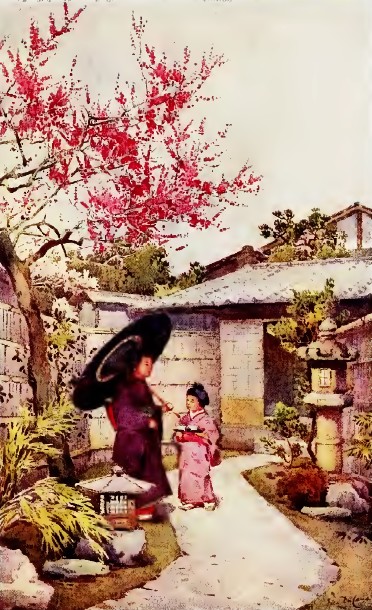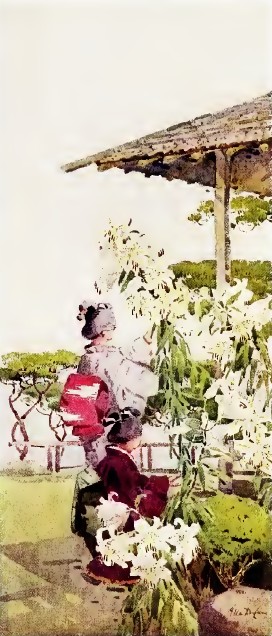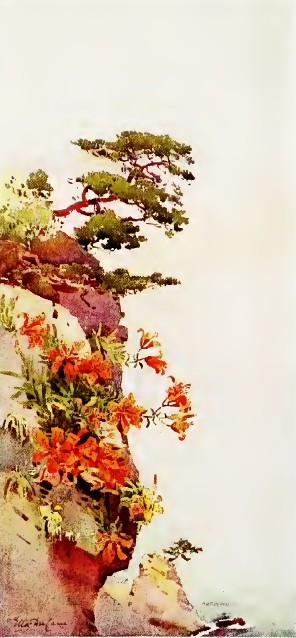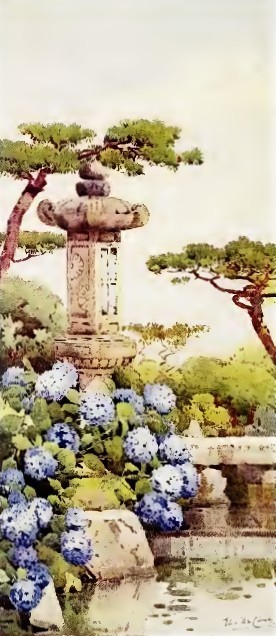| Web
and Book design,
Copyright, Kellscraft Studio 1999-2013 (Return to Web Text-ures) |
 (HOME)
|
| CHAPTER
VI SUMMER FLOWERS MAY is essentially the flower month in Japan, and a ramble through the country cannot fail to be a never-ending joy and surprise to the flower lover. It was nearly the middle of the flower month when, wearied of the works of man, the glories and splendour of the endless round of temples, museums, theatres, no dances, and the usual sights which all new-comers to the country must be introduced to, I started for Matsushima, the land of the pine-clad islands. I had not expected to find flowers there, but rather change of scene and peace. I felt that for a time I must be "far from the madding crowd." It is a fairy scene which greets the eye in the early dawn after a long and dusty journey, and I had to look and look again to make sure that these tiny phantom islands were real and solid, not merely shadows on the water, or even a moored junk, which presently would pass on and vanish from the scene. As the sun rose higher the islands stood out clear in the yellow morning light, then one realised why they are called collectively Matsushima — Pine Islands, — for, however tiny it may be, each isle has to support its burden of twisted, bent, and leaning trees. How the seed has ever found the crannies and cracks between the rocks in which to ripen, and eventually develop into those fantastic trees, was a never-ending source of marvel and admiration to me. Think of the cruel winter snows, and storms blowing in from the Pacific, that these trees have had to withstand from their earliest infancy; small wonder that some appear to have more spreading roots than branches. Many an idle day was spent exploring this little host of islands, some with their rosy carpet of azalea, perhaps not more than a few inches high, creeping along close to the ground as if seeking protection from the fierce winter gales. None the less beautiful for being dwarfed, it seemed rather as though this fiery pink azalea had taken the place of ground ivy, and what a beautiful remplaçant! On other islands the wild wistaria had flung its long vine-like branches from tree to tree, and suggested the lianes of a tropical forest; one scrambled knee-deep in many of the hardier ferns to attain the summit of Ogidani, in order to gaze across the whole lagoon and out to Kinkwosan; shrubs of bird-cherry were in all their glory; and many others unknown to me helped, in this month of flowers, to make them not only pine-clad but flower-clad islands. It was with genuine regret that I left behind this enchanted land, and with the cries of "Sayonara" and "Please come again" ringing in my ears I turned my back on the Toyo Hotel and its hospitable owner; but time was slipping by, and though it would have been easy to dream away months here, I feared I might become a mere loafer, so, after watching the sun set one evening late in May, I returned once more to the railway, and the commonplace. The train took me back to Itsunomiya through wilder country than I had ever seen on any other railway line in Japan. Bandai San stood glowering and threatening in the distance, and we sped past pine-clad ridges and mountain streams, down to the lower land where glowing rose-coloured azalea seemed to grow as hazel or hornbeam undergrowth in England. One flashed past broad stretches of colour, growing fewer and smaller where the ruthless hand of the cultivator had no doubt found out that the fertile soil would grow other things more profitable, but how far less beautiful, than wild crimson satsuki I was bound for Nikko on an "azalea pilgrimage," for surely every traveller should not fail to see the Nikko azaleas in all their glory, and later in the year the maples, which vie with the cryptomerias for the palm of beauty. The glorious avenue of cryptomerias which lined the old road to Nikko has suffered from the hands of time and man; but long stretches of the splendid old trees still remain, and form a fitting approach to the little mountain village, celebrated throughout the length and breadth of the world for its mortuary shrines, whose final peacefulness and simplicity seem so striking after the ornate splendour and gorgeous colouring of the outer gates and temples. But it was azaleas, not temples, that I had come to see this time at Nikko, and surely no one could be disappointed. Climbing up the hill, every shade from delicate pink to clear red, pale transparent yellow, and even rosy purple, seems to have run riot in a veritable feast of colour. Little shrines nestle by the path, perhaps sheltering a small stone image of Jizo the Helper, the travellers and the children's God; so we ask his kindly aid, and add our contribution to that of hundreds of other travellers, and pause to gaze by his side at the landscape — across the valley where the river threads its way, now a harmless-looking stream, but in autumn to be swollen into a dangerous roaring torrent, sweeping along, leaving death and destruction in its wake. The azaleas here are not the satsuki of Matsushima, but the Azalea Beni Renge, leafless as yet, as the flowers seem so thick upon their stems they leave no room for leaves. Their honeysuckle scent filled the air, and hither and thither darted huge black butterflies, looking strangely like humming-birds, only pausing for a second to suck a drop of honey, and then on again to another, perhaps more freshly opened flower. I noticed these same black butterflies always haunt red or deep pink flowers. Is it vanity on their part — are they stopping to think how admirably the colour contrasts with their own glossy black wings? Then I remembered that the first time I ever saw a humming-bird it was darting from one crimson hibiscus flower to another. Was that also vanity? Or have crimson flowers sweeter or more delicately flavoured honey than the rest? As the mountain road winds higher and higher above Nikko, on its way to Chuzenji, we left behind this variety of azalea, and came upon another quite unknown to me. At first I thought the mountain-sides were covered with peach-trees, whose blossoms lingered on in the higher or bleaker regions, but it was not so, all was azalea; some so tall that their bare stems stretched high among the other trees, before they got enough light and air to wreathe their branches with the peach-coloured blossoms. On these, lichen seemed to take the place of leaves; the effect is indescribable to one who has not seen it: the soft greenish-grey tufts clothe the stems, which might without their furry covering look lean and bare; but all this beauty suggests weeks of autumn rain and damp heat, more healthy for plant life than for man. Often the path would be strewn with freshly fallen blossoms, and there overhead one could see the pink flowers against the sky. The banks and moorland were full of tender shoots and buds of shrubs and flowers, which in July will be an endless source of surprise and delight to the wild-flower hunter. Leaving Nikko behind in all its gay clothing, I bent my steps towards the Watanase valley, one of Japan's most beautiful valleys. The early summer is indeed a harmony in greens; the maples had hardly lost their spring colouring when I started in the early dawn from Ashio to follow the course of the river which dashes down some hundred feet or more below the road with a thundering roar, and certainly the valley well deserves its celebrity. The Paulonia trees were then in all their beauty, and side by side with great masses of their purple flowers the wild fie wreathed the trees with its delicate mauve blossoms, until at last I felt that the valley ought to be called the "purple valley." A few tree peonies were shedding their last petals in a tiny garden where we stopped to rest and sip the inevitable little cup of pale green tea, reminding one that summer had come and spring was gone, not to come again until the scorching summer months, the autumn storms, and winter snows had come and gone.  The Kobai Plum Blossom In early summer the higher moorlands afford a happy hunting-ground for the flower collector. Purple iris and white rue seem to fight their way among the moorland grasses, here and there a Turk's-cap lily raises its scarlet head proudly, the purple bells of the Platycodon are just opening, and the wild white and pink campanula is already fading. The columbine, not the glorified hybrid Aquilegia of our English gardens, but the humble pale-coloured wild columbine with its long spurs and delicate fern-like foliage; yellow valerian, mauve and white funkias, pink spiræas, Solomon's seal, endless varieties of orchises, and in favoured districts the pale pink Cypredium macranthum are among the summer wild flowers, scattered over the plain or nestling on the banks of the mountain streams. The flowering shrubs seemed endless; think how many shrubs introduced into Europe of late years are "japonica"; all these find their homes in one district or another. Besides all the varieties of plum, cherry, and peach, in spring the andromeda bushes are laden with their white bell-flowers, suggestive of a waxy lily of the valley, to be followed by their young leaves as bright as any flowers; every variety of crabs, white deutzias, spiræas, weigelias, the wild white syringa, which also seemed to differ from our garden variety, save only in its delicious odour; and a form of Rhincospernum jasminoides which I had not seen before, whose heavy scent filled the air at sundown. All these I can recall having come across during my summer rambles, and doubtless there are many more. In the later summer months I wandered along the beautiful coast of the province of Izu, which again seemed to be a home of flowers. The tall spikes of Bocconia cordata reared their heads proudly wherever they had escaped the hand of the destroyer; apparently the plant is regarded by the country people as either poisonous or unlucky, as often a splendid clump of it, its height showing how thoroughly it appreciates the deep rich soil, will be here to-day and gone to-morrow, cut off and trampled down with evident intention. This coast seemed to be the home of the hydrangea and also of many different varieties of lilies. In May, on the lower ground of Hiezan, and especially in the neighbourhood of Lake Biwa, the pale pink Lilium Krameri may be found in tufts nestling under the shadow of some sheltering shrub, and scattered throughout the district the various forms of Lilium umbellatum, but the province of Izu seems to have soil more suited to the late summer lilies. By the middle of July the big buds of the Lilium auratum will be fighting their way among the rank growth along the roadside, and in a few days the air will be filled with their scent. Often I was attracted by their fragrance, perhaps all the more remarkable in a land which, alas! is not famed for sweet smells, and then far above one's head, hanging defiantly out of reach, could be seen a single splendid bloom of this king among lilies. They seem to love the shelter and dampness of the wood, where the falling leaves each autumn make a fresh covering for their bulbs. Once I tried to see how deep in the earth the bulbs were buried, but I did not succeed in getting down low enough, and could only tell, from the mark on the stem of the lily which had been pulled, that about eight to ten inches seemed to be the usual depth of the bulb. Often the stems seemed to bear only one splendid bloom, but I was told that was only because the bulbs were young, and even in their wild state from six to eight perfect blooms on one head were not uncommon. There appeared to be every variety of auratum, and I noticed that the broad-leaved platyphyllum seemed even more sturdy than the rest, the foliage a deeper green, and the individual blossoms more perfect, the markings more distinct, and their scent, if such a thing were possible, even stronger and more overpowering than the more slender-growing Auratum virginals.
 Lilium Auratum Then there were the Rubro Vittatum with their band of pink down each petal, but never in a purely wild state did I see it so deep in colour and truly defined as in the cultivated form which is exported under that name. It was in the cottage gardens that I saw the finest lilies, and many a giant bearing from twenty to thirty unblemished blooms, at the top of a stem some six or seven feet high, clad with equally unblemished foliage, was brought to me, as it soon became known that the "foreigner" staying at Atami had come especially to see their yuri no hana. Not that the Japanese seem ever especially to admire them, and they are not included among their "seven beautiful flowers of late summer." Mr. Parsons gives an example of this fact: —
I was walking one day at Yoshida with a Japanese artist, a remarkable man, who was engaged in making a series of steel engravings, half landscape, half map, of the country round Fuji, and called his attention to a splendid clump of belladonna lilies growing near an old grey tomb; but he would not have them at all, said they were foolish flowers, and the only reason he gave me for not liking them was because they came up without any leaves. When we got back to our tea-house he took my pen and paper and showed me what were the seven beautiful flowers of late summer: the convolvulus, the name of which in Japanese is "asago," meaning the same as our "morning glory "; wild chrysanthemum; yellow valerian; the lespedeza, a kind of bush clover; Platycodon grandiflorum and purple blue campanula; Eulalia japonica, the tall grass which covers so many of the hills; and shim, a rather insignificant aster. I noticed that some versions of the seven flowers differed from his; a large flowered mallow is often substituted for the last he named. There are doubtless different schools which hold strong views on the subject, but on the "morning glory" and some others they are evidently agreed.
The tiger lilies were in bloom in the village gardens, but never in any great number — a clump here and there, for they are seldom allowed to bloom, it is for their bulbs they are cultivated; this is their "edible lily," and young bulbs of Lilium tigrinum are among their most prized vegetables. I had noticed a square bed of these lilies suggestive of an asparagus bed, in a priest's garden in Kyoto in May, and thought what a wealth of colour they would provide later in the year; but next time I saw the garden, early in June it may have been, the lilies had all been executed — just their heads cut off, — and when I expressed amazement and regret I was told that this was always done to strengthen the bulb. The variety did not seem to be as fine as those grown under the name of Tigrinum Fortunii in England, and yet more robust and with larger heads than our common tiger lily; probably the different soil and damper climate would account for this. The apricot-coloured Lilium Batemanni seemed to know how to protect their bulbs from the hand of the collector, for jutting out between the rocks, hanging perhaps a hundred feet above the sea, these lilies grow, tantalising to those who want to pick them, for these rocks are not easy to climb; but how beautiful they are, their clear colour standing out against the grey cliffs and the restless deep blue sea below. The cultivation of lilies for exporting seems to have developed into quite an important industry in Japan of late years; the district round Kamakura and right away to Yumoto appeared to be the best soil for their culture. I never saw any Lilium longiflorum in their wild state, but thousands, I should think millions, of bulbs of this lily are exported annually, in all its different forms. For indoor growing the variety known as Harrisii seems still to be the favourite; though giganteum is a stronger form, and certainly is to be preferred for the open ground. Multiflorum is for the impatient grower, as it flowers some three weeks earlier, though it is a more slender kind; and there are many others. Even in Japan the dreaded disease among Lilium auratum seemed to be not unknown; apparently cultivation brings it in its train, as in fields and gardens I noticed occasionally the fatal yellow leaves, which means death to the bulb; and the other form of disease known as "clubbing" may occur, even when the lilies are growing in their natural state — the two stems grown into one, and the monster head so closely packed with blossoms that none can develop to their full size or beauty; on one head alone I counted over a hundred blooms, but the effect was only that of a poor deformity.  Lilies on the Rocks, Atami
Very beautiful were the large bushes of hydrangea, their branches weighed down by their burdens of immense heads of bright blue flowers. In some parts of England where there is iron in the soil, hydrangeas in the open ground are blue, but what a poor washed-out blue compared to the intensely deep colour of this Japanese variety, Ajisia Aiyaku, meaning the blue hydrangea. Their great balls of blossom change from a pale yellow green to bright blue, brighter almost than the sky above, and as they fade, they turn to rosy purple, and back again to a dull green, clinging with ungraceful tenacity to life, as though loth or afraid to die, preferring to rot on their stem rather than drop untimely — unlike the blossoms of spring, ever ready to depart life at the call of nature. A more graceful form is Hortensis Shirogaku, with its more loosely formed heads, never forming a densely packed mass, each individual blossom showing, with the outer petals of a much paler colour in contrast with the deep blue centres. They are moisture-loving plants, as they seem to flourish best on the very brink of the miniature mountain torrents. The garden at Atami known as the Bai-en, celebrated for its early plum blossoms, was gay with great bushes of these shrubs in July; they clothed the banks of the roaring stream, till, as their heads grew heavier, the lower branches were swept by the water. In the early days of August the hedges and banks in the low country were beginning to look parched and dusty, waiting for the autumn rains, which never fail, and will bring new life and freshness to all the herbage, but not new flowers — the season of wild flowers is nearly gone; though the autumn will bring us the true "lily of the field," the scarlet Nerine japonica — a lily of the field, as it is only growing along the edges of the rice patches on neglected banks or nestling among the grey stone tombs of some forgotten graveyard, that you will ever see these lilies. Never in any garden however ill kept, never in any house, and never used as any form of decoration did I see this lily; for are they not the "death flower," the flower of ill omen, or sometimes the "equinox flower," also suggestive of a season full of death and decay. Nerine or Lycoris japonica,  An Hydrangea Bush or the spider lily — its name seems difficult to determine — made the land gay in the fading year, gorgeous splashes of colour against the ripening rice, its fringed heads rising leafless from the soil, sometimes in scattered tufts, and sometimes great banks closely covered with their flaunting heads. I felt Japan must indeed be rich in flower treasures for such a one to be overlooked and uncared for. Perhaps in the South of England it might find a home — a resting-place where it would be treasured, not destroyed; at the foot of a grey stone wall a few tufts of this brilliant lily would be a "thing of beauty," though not "a joy for ever." By November the flower year is over; the last chrysanthemum pots are being hurried under their temporary shelters, away from the danger of the early frost, which any night may turn the country into a blaze of scarlet and gold. Not only the maples will help the year to die in splendour, for so many other trees have as great a variety of colour, though perhaps not quite so brilliant, and the dark leaves of the tulip-trees will presently turn to a sheet of gold, the larch will be shedding its pale yellow spines, while the Japanese oak, Shira Kashi, with its ruddy colour will help to relieve the solemn everlasting green of the pines and cryptomerias which clothe the hills. The ripened rice is being quickly stored, and only the grasses and foliage of herbaceous plants are left to give a note of colour to the fields and higher moorland; the tall Eulalia japonica, waving in the wind, clothes the golden hills, but will soon be beaten down by the winter snows. So in a blaze of glory the year ends in this Land of Flowers. |